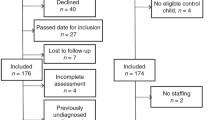Abstract
Recently aortic intima-media thickness (IMT) has been used as an earlier marker of preclinical atherosclerosis in high-risk children, such as those with type 1 diabetes mellitus and hypercholesterolemia. Children who were born preterm have an early elevation in insulin resistance, which may be a risk factor for metabolic syndrome in adulthood. However, there is no optimal marker of subsequent cardiovascular disease for children born preterm. In this study, we aimed to evaluate the effect of preterm birth on aortic IMT during the preschool period. Mean aortic IMT was measured by ultrasound in 26 subjects born preterm (gestational age <37 weeks [preterm group]) and 11 control subjects born at term (term group). The mean aortic IMT of the preterm group was significantly thicker than that of the term group (preterm group: median 577 μm, interquartile range (524–599) versus term group: 517 μm (442–544); p = 0.003). Mean aortic IMT may be one of the earlier markers of subclinical vasculopathy in preschool children who were born preterm.



Similar content being viewed by others

References
Baldassarre D, Amato M, Bondioli A, Sirtori CR, Tremoli E (2000) Carotid artery intima-media thickness measured by ultrasonography in normal clinical practice correlates well with atherosclerosis risk factors. Stroke 31:2426–2430
Crispi F, Bijnens B, Figueras F, Bartrons J, Eixarch E, Le Noble F et al (2010) Fetal growth restriction results in remodeled and less efficient hearts in children. Circulation 121:2427–2436
Dawson JD, Sonka M, Blecha MB, Lin W, Davis PH (2009) Risk factors associated with aortic and carotid intima-media thickness in adolescents and young adults: the Muscatine Offspring Study. J Am Coll Cardiol 53:2273–2279
Facchini FS, Hua N, Abbasi F, Reaven GM (2001) Insulin resistance as a predictor of age-related diseases. J Clin Endocrinol Metab 86:3574–3578
Geerts CC, Bots ML, van der Ent CK, Grobbee DE, Uiterwaal CS (2012) Parental smoking and vascular damage in their 5-year-old children. Pediatrics 129:45–54
Gunes T, Koklu E, Yikilmaz A, Ozturk MA, Akcakus M, Kurtoglu S et al (2007) Influence of maternal smoking on neonatal aortic intima-media thickness, serum IGF-I and IGFBP-3 levels. Eur J Pediatr 166:1039–1044
Harrington J, Pena AS, Gent R, Hirte C, Couper J (2010) Aortic intima media thickness is an early marker of atherosclerosis in children with type 1 diabetes mellitus. J Pediatr 156:237–241
Hofman PL, Regan F, Jackson WE, Jefferies C, Knight DB, Robinson EM et al (2004) Premature birth and later insulin resistance. N Engl J Med 351:2179–2186
Ikari Y, McManus BM, Kenyon J, Schwartz SM (1999) Neonatal intima formation in the human coronary artery. Arterioscler Thromb Vasc Biol 19:2036–2040
Jarvisalo MJ, Jartti L, Nanto-Salonen K, Irjala K, Ronnemaa T, Hartiala JJ et al (2001) Increased aortic intima-media thickness: a marker of preclinical atherosclerosis in high-risk children. Circulation 104:2943–2947
Koklu E, Kurtoglu S, Akcakus M, Yikilmaz A, Coskun A, Gunes T (2007) Intima-media thickness of the abdominal aorta of neonate with different gestational ages. J Clin Ultrasound 35:491–497
Koklu E, Ozturk MA, Kurtoglu S, Akcakus M, Yikilmaz A, Gunes T (2007) Aortic intima-media thickness, serum IGF-I, IGFBP-3, and leptin levels in intrauterine growth-restricted newborns of healthy mothers. Pediatr Res 62:704–709
Mannami T, Konishi M, Baba S, Nishi N, Terao A (1997) Prevalence of asymptomatic carotid atherosclerotic lesions detected by high-resolution ultrasonography and its relation to cardiovascular risk factors in the general population of a Japanese city: the Suita study. Stroke 28:518–525
McGill HC Jr, McMahan CA, Herderick EE, Malcom GT, Tracy RE, Strong JP (2000) Origin of atherosclerosis in childhood and adolescence. Am J Clin Nutr 72:1307S–1315S
McGill HC Jr, McMahan CA, Gidding SS (2008) Preventing heart disease in the 21st century: implications of the Pathobiological Determinants of Atherosclerosis in Youth (PDAY) study. Circulation 117:1216–1227
Meenakshisundaram R, Devidutta S, Michaels AD, Senthilkumaran S, Rajendiran C, Thirumalaikolundusubramanian P (2011) Significance of the intima-media thickness of carotid and thoracic aorta in coronary artery disease in the South Indian population. Heart Views 12:150–156
Milei J, Ottaviani G, Lavezzi AM, Grana DR, Stella I, Matturri L (2008) Perinatal and infant early atherosclerotic coronary lesions. Can J Cardiol 24:137–141
Norman M (2008) Low birth weight and the developing vascular tree: a systematic review. Acta Paediatr 97:1165–1172
Skilton MR, Evans N, Griffiths KA, Harmer JA, Celermajer DS (2005) Aortic wall thickness in newborns with intrauterine growth restriction. Lancet 365:1484–1486
Skilton MR, Viikari JS, Juonala M, Laitinen T, Lehtimaki T, Taittonen L et al (2011) Fetal growth and preterm birth influence cardiovascular risk factors and arterial health in young adults: the cardiovascular risk in young Finns study. Arterioscler Thromb Vasc Biol 31:2975–2981
The standard value committee of the Japanese society for pediatric endocrinology and the Japanese association for human auxology (2012). http://jspe.umin.jp/taikakushisuv1.xlsx. Accessed 9 Feb 2012
Trevisanuto D, Avezzu F, Cavallin F, Doglioni N, Marzolo M, Verlato F et al (2010) Arterial wall thickness and blood pressure in children who were born small for gestational age: correlation with umbilical cord high-sensitivity C-reactive protein. Arch Dis Child 95:31–34
Acknowledgments
We thank the study participants and their parents for enrollment and commitment to our study.
Conflict of interest
The authors declare that they have no conflict of interest.
Author information
Authors and Affiliations
Corresponding author
Rights and permissions
About this article
Cite this article
Shimizu, T., Fujii, T., Iwasaki, J. et al. Abdominal Aortic Intima-Media Thickness in Preschool Children Born Preterm. Pediatr Cardiol 35, 121–125 (2014). https://doi.org/10.1007/s00246-013-0750-0
Received:
Accepted:
Published:
Issue Date:
DOI: https://doi.org/10.1007/s00246-013-0750-0



